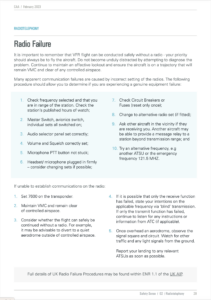The Charity
Aviation
Maritime
GA1327a

Initial Report
On a recent trip at a nearby Airfield, the airfield frequency was set by my pilot colleague upon being released from controlled airspace nearby. With only 10 miles to run, he called the airfield but got no response but we could hear aircraft in the circuit. I called as well from my side in case his mic or ptt button had failed but with the same result. As we were getting near the field he called blind announcing that we were joining overhead for the runway that we had ascertained from the circuit calls. Upon joining overhead we saw another aircraft in the overhead to the right that we positioned behind and followed him to crosswind. As we were about to join downwind we were alerted by a radio call asking if the aircraft joining had them in sight. We then positioned behind that aircraft giving blind calls throughout.
Upon landing we were approached by the CFI saying that he had had complaints from other pilots that we were not making radio calls. We replied that we had been making calls throughout and that their base radio operator had not responded to our initial calls for airfield information. However, upon leaving and requesting airfield information we were getting unreadable to our calls. We checked all of the normal issues etc believing that it was a fault on our radio system that was causing a transmit problem. I then checked the frequency and discovered that it had been set to .005 out of the correct frequency and, once set right, both transmit and receive worked perfectly.
I wrote to the Chief Flying Instructor at the Airfield and apologised for our error but expressed concern that setting the wrong frequency by the small amount permitted calls to be received but not transmitted leading to the belief that blind calls were being received. I have suggested that they may wish to have an entry made in The Flight Guides warning of this situation. The situation was exacerbated by the Airfield having an unconventional circuit to avoid a nearby village with aircraft joining long downwind and on a dogleg and not being in the expected position. Also on the day, the circuit was very busy with a number in the circuit at that time. I am also aware that some pilots are still flying using non 8.33kHz radios and that the same problem of receiving but not being received exists which is not the case on most other frequencies where a non 8.33kHz radio will continue to transmit and receive without any problems on those frequencies.
The main lesson learned is to double check that the frequency is exactly right and not assume that if you can hear them they can hear you. On blind calls at least try and get a response from an aircraft at the field as a radio check.
CHIRP Comment
The reporter highlights a useful lesson when confronted with a seeming partial radio failure that compromised only their transmit function. It’s easy to convince yourself that there’s a fault in your system under such circumstances, especially if you’re arriving at an unfamiliar airfield, so a methodical check of switch and frequency selections is an important first step before assuming the worst. Page 138/139 (Emergencies section) of the Skyway Code provides a useful checklist regarding communications issues, not least of which reminding us that “Many apparent communication failures are caused by incorrect setting of the radios – check basic issues like volume, squelch, frequency and audio selector panel settings before concluding you have actually experienced a radio failure”. Also, CAA Safety Sense Leaflet 22 Page 29 (see graphic) contains a useful checklist for radio failures – given that there are radios with switchable 8.33kHz vs 25kHz functionality, we would suggest that the associated item 4 in the first list might be modified to read: ‘Volume, Squelch and Frequency selectors correctly set’. In extremis, if you’re approaching controlled airspace with no comms you might even get intercepted so make sure you’re aware of the rules on interception as well (noting that the CAA Safety Sense 11 ‘Interception’ guide has been withdrawn for a re-write at present).
Key Issues relating to this report
Dirty Dozen Human Factors
The following ‘Dirty Dozen’ Human Factors elements were a key part of the CHIRP discussions about this report and are intended to provide food for thought when considering aspects that might be pertinent in similar circumstances.
Pressure – continuing with airfield join before fully investigating the problem
Awareness – frequency not checked to make sure correctly set
Communication – unable to communicate with others in the visual circuit
Deviation – did not fully follow a ‘radio failure’ procedure
This data type is not supported! Please contact the author for help.